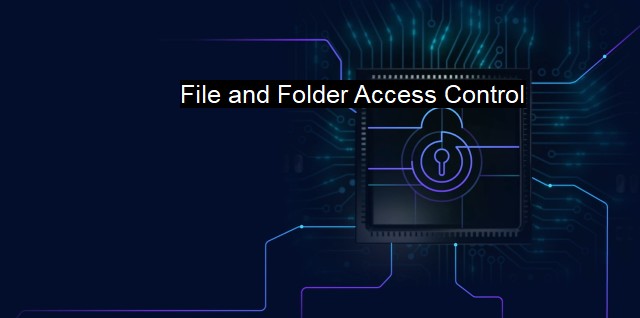What is File and Folder Access Control?
The Importance of File and Folder Access Control in Cybersecurity and Antivirus: Protecting Data and Preventing Cyber Attacks through Encryption and Authorization
File and Folder Access Control is an essential element within cybersecurity. In the age of digital information, data security is a prime concern, both for individuals and organizations. One important way to ensure sufficient protection of digital information is by exercising proper control over the access to files and folders. Simply put, File and Folder Access Control is the method utilized including the tools, processes, and regulations for managing access to the files and folders present in a computer system or a network.Access control involves setting parameters determining which users possess what level of user rights to system data as well as specifying the actions that users can execute within a server or a domain. The objective is to decrease the risk of illicit access to sensitive data, thus declining the risk of data destruction or data theft, which often causes severe problems and costs for both individuals and organizations.
There are two primary types of File and Folder Access Control. Discretionary Access Control (DAC), in which the data owner determines who is capable of accessing specific resources with an emphasis on granting or limiting access to objects based on the identity of subjects and discretion of the owner. Mandatory Access Control (MAC), where access rights are allocated to files based on the confidential schema attached to the documents.
A pivotal aspect of File and Folder Access Control is to develop a system accessible only to authenticated users. Therefore, access control technologies come with authentication mechanisms that are used to verify the genuineness of users before granting access. It could be, for instance, password protection, biometric authentication, or multi-factor authentication combining several methods.
Another significant bit of access control is having an audit trail of who has accessed what and when. This access log acts as a key tool in diagnosing offenses and identifying culprits or security gaps. Any data breach can help cybersecurity professionals in analyzing where a system's security was compromised and how similar breaches could be prevented in the future.
Integral to antivirus programs, the File and Folder Access Control feature monitors access to specific areas of the computer. By scrutinizing the actions of programs and scripts continually, it evaluates potential risks and thwarts virus attacks by denying access to suspicious sources.
File and Folder Access Control is imperative for securing shared files across a network. It allows administrators to limit various users’ access to a file or folder. Some users might need full access to the data, while others may only need to read data— without the ability to define these actions, you leave your files exposed to changes, and potentially, corruption or deletion.
Cloud-based access controls have merged as a robust solution for organizations moving their operations to cloud platforms. These access controls allow organizations to have full command over their data security in real-time, regardless of data location, simplifying access management and driving security effectiveness.
Having an efficient File and Folder Access Control is a necessity for insuring sensitive data against security breaches, mitigating the risk of unauthorized intrusions, protecting shared files across networks, sustaining accountability, and preserving necessary order and security standards. Antivirus software plays a complementary role in this front, further bolstering File and Folder Access Control by actively scanning and preventing unauthorized access, hence adding an extra layer of defence against potential cybersecurity threats.

File and Folder Access Control FAQs
What is file and folder access control?
File and folder access control is a security measure that allows organizations to regulate who has access to certain files and folders within their network. This ensures that sensitive information remains confidential and only authorized personnel have access to it.How can file and folder access control benefit an organization in terms of cybersecurity?
File and folder access control can enhance an organization's cybersecurity by limiting the risk of unauthorized access to sensitive data. By controlling access to important files and folders, organizations can reduce the likelihood of cyber attacks and data breaches.What are some common methods of file and folder access control?
Some common methods of file and folder access control include access control lists (ACLs), user permissions, and encryption. These methods allow administrators to assign specific levels of access to different users or groups, ensuring that only authorized users can view, modify, or delete files and folders.How does antivirus software fit into file and folder access control?
Antivirus software can play a key role in file and folder access control by scanning files for malware and other threats. This helps prevent malicious actors from gaining access to sensitive data or using it to carry out attacks. By combining access control measures with antivirus software, organizations can strengthen their cybersecurity defenses and protect their valuable information.| | A | | | B | | | C | | | D | | | E | | | F | | | G | | | H | | | I | | | J | | | K | | | L | | | M | |
| | N | | | O | | | P | | | Q | | | R | | | S | | | T | | | U | | | V | | | W | | | X | | | Y | | | Z | |
| | 1 | | | 2 | | | 3 | | | 4 | | | 7 | | | 8 | | |||||||